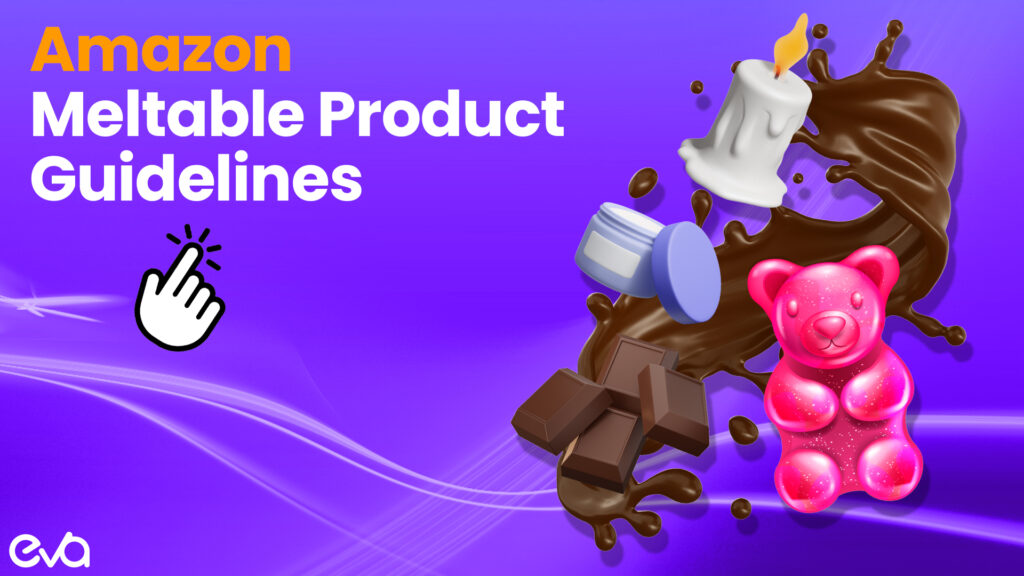Table of Contents
- Introduction
- Why Amazon Has Meltable Product Guidelines
- Amazon’s Meltable Inventory Policy
- Guidelines for Sellers Handling Meltable Products
- How to Prepare Your Meltable Products for Amazon FBA
- Best Practices to Avoid Issues
- Strategies for Selling Meltable Products Year-Round
- Marketing Tips
- How Eva Can Help with Managing Meltable Products on Amazon
- Conclusion
- FAQs
Introduction
Selling meltable products on Amazon, such as chocolates, gummies, and other temperature-sensitive items, can be highly profitable, especially during peak seasons like holidays or special events.
However, these products come with unique challenges due to their tendency to get damaged or melt during storage and shipping.
This issue is particularly relevant when dealing with fluctuating temperatures that can cause these products to lose their shape, quality, or even become unsafe for consumption.
Ignoring Amazon’s meltable product guidelines can lead to severe consequences, such as product delisting, account suspension, and increased customer complaints.
To succeed in this niche market, it’s critical to understand and strictly follow Amazon’s guidelines for meltable products.
What Are Amazon Meltable Products?
On Amazon, meltable products are defined as items that are likely to melt, deform, or degrade when exposed to temperatures above a certain threshold.
According to Amazon, any product that liquefies, deforms, or loses its integrity at temperatures above 75°F (24°C) is considered meltable.
Understanding this definition is crucial for sellers, as it directly impacts how their products are stored, handled, and shipped within Amazon’s fulfillment network.
Knowing whether your products fall into this category is the first step toward ensuring compliance with Amazon’s guidelines.
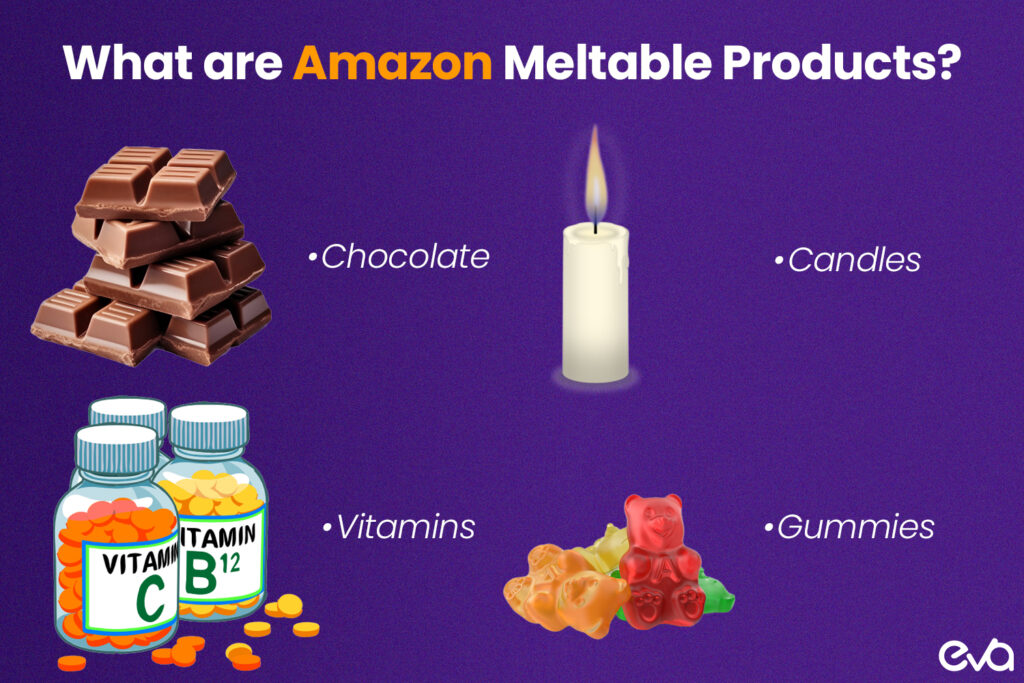
Examples of Meltable Products
To better grasp what qualifies as a meltable product, consider the following common examples:
- Chocolates: These are popular items, especially during holidays like Christmas and Valentine’s Day. However, chocolates are highly susceptible to melting if not properly stored and shipped.
- Gummies: Gelatin-based products like gummies can easily become sticky or deformed when exposed to heat, affecting their appearance and texture.
- Certain Cosmetics: Products like lipsticks, cream-based cosmetics, and certain balms are prone to melting in high temperatures, rendering them unusable or unsafe.
- Candles: Wax-based items, such as candles, can soften or warp when exposed to warm conditions, which can be especially problematic during summer months.
Understanding which of your products fall under this category is crucial. It allows you to take the necessary steps to ensure they are stored, packaged, and shipped in line with Amazon’s meltable product guidelines.
Temperature Sensitivity
The temperature sensitivity of these products is a significant concern. Meltable products require careful handling, especially during the warmer months, to prevent them from losing their integrity before reaching the customer.
Improper handling or inadequate packaging can lead to products arriving melted or deformed, resulting in customer dissatisfaction, increased returns, and negative reviews.
To avoid these issues, it’s important to maintain your products below the critical temperature threshold of 75°F (24°C) throughout the storage and shipping processes.
This ensures that the products retain their quality and appeal when they reach the consumer.
Amazon’s Criteria for Meltable Products
Amazon has set specific criteria to determine whether a product is classified as meltable. These criteria include:
- Temperature Threshold: Products that can melt or be damaged at temperatures above 75°F (24°C) are considered meltable.
- Product Type: This classification applies to a wide range of products, including food items, beauty products, and certain household goods.
- Packaging and Storage Requirements: Products that require special packaging to maintain their integrity at higher temperatures must comply with Amazon’s guidelines.
Table: Amazon’s Meltable Product Criteria
| Criteria | Description |
| Temperature Sensitivity | Products that melt or degrade above 75°F (24°C). |
| Types of Products | Includes chocolates, gummies, certain cosmetics, and candles. |
| Packaging Requirements | Must use packaging that protects products from heat during storage and shipping. |
By understanding these criteria, sellers can better prepare their products for storage and shipping, ensuring they meet Amazon’s standards and avoid potential penalties.
Why Amazon Has Meltable Product Guidelines
Ensuring Consumer Satisfaction
Amazon’s meltable product guidelines are essential for ensuring that customers receive their orders in the best possible condition.
Maintaining product quality is vital for preserving customer satisfaction, which is crucial for generating repeat business and fostering brand loyalty.
When customers receive products that have melted or been otherwise compromised during transit, it leads to disappointment, returns, and negative reviews.
By adhering to Amazon’s guidelines, sellers can significantly reduce the likelihood of such issues, helping to build a positive reputation and encourage repeat purchases.
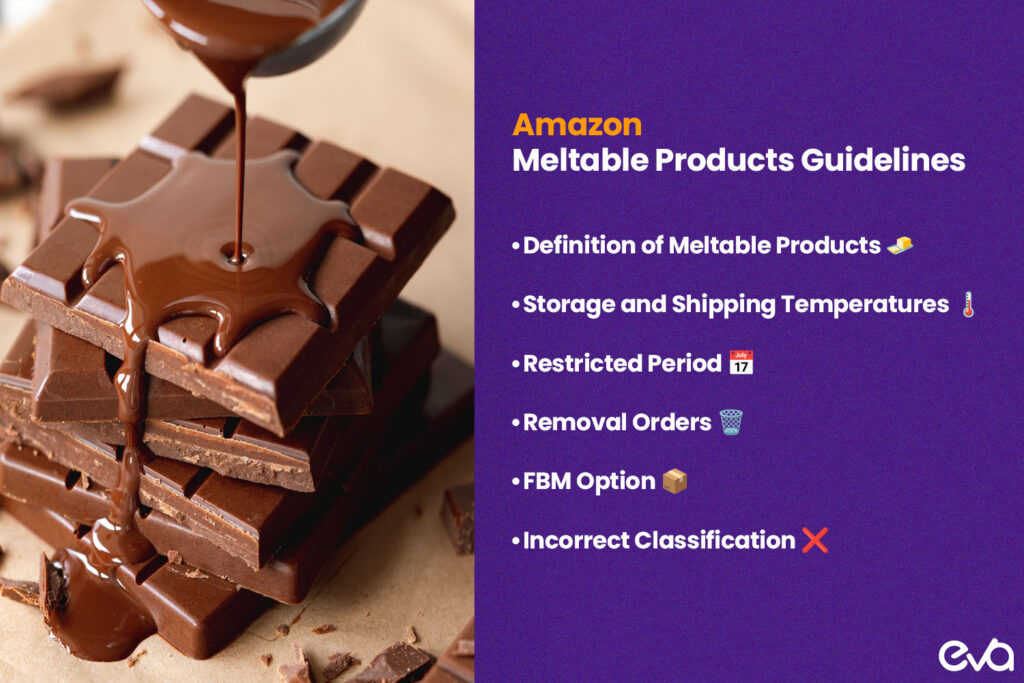
Amazon’s Responsibility in Maintaining Marketplace Standards
As one of the world’s largest e-commerce platforms, Amazon must uphold high standards across its marketplace.
This includes setting and enforcing guidelines for products that are prone to damage under certain conditions, such as meltable items.
These guidelines help Amazon manage its vast marketplace effectively, reducing the number of customer complaints related to melted or damaged products.
Additionally, they protect Amazon from potential liability issues that may arise if customers receive unsafe or unsatisfactory products.
By enforcing these guidelines, Amazon ensures a consistent shopping experience for all customers, which is crucial for maintaining its reputation as a reliable marketplace.
Addressing Safety Concerns
Safety is another important factor driving Amazon’s meltable product guidelines. Melted products, particularly in the food and cosmetics categories, can pose health risks.
For instance, chocolates that have melted and re-solidified might not only lose their shape but could also harbor bacteria if not handled correctly.
Similarly, cosmetics that have melted might not apply as intended or could cause skin irritation.
Amazon’s Meltable Inventory Policy
Policy Overview
Amazon’s meltable inventory policy is designed to regulate how temperature-sensitive products are handled within its fulfillment centers, particularly during the warmer months.
This policy outlines the restrictions on storage and shipping for meltable products, ensuring they are only available during periods when the risk of melting is minimal.
Sellers must be fully aware of these restrictions to avoid disruptions in their operations and ensure that their products remain available to customers in optimal condition.
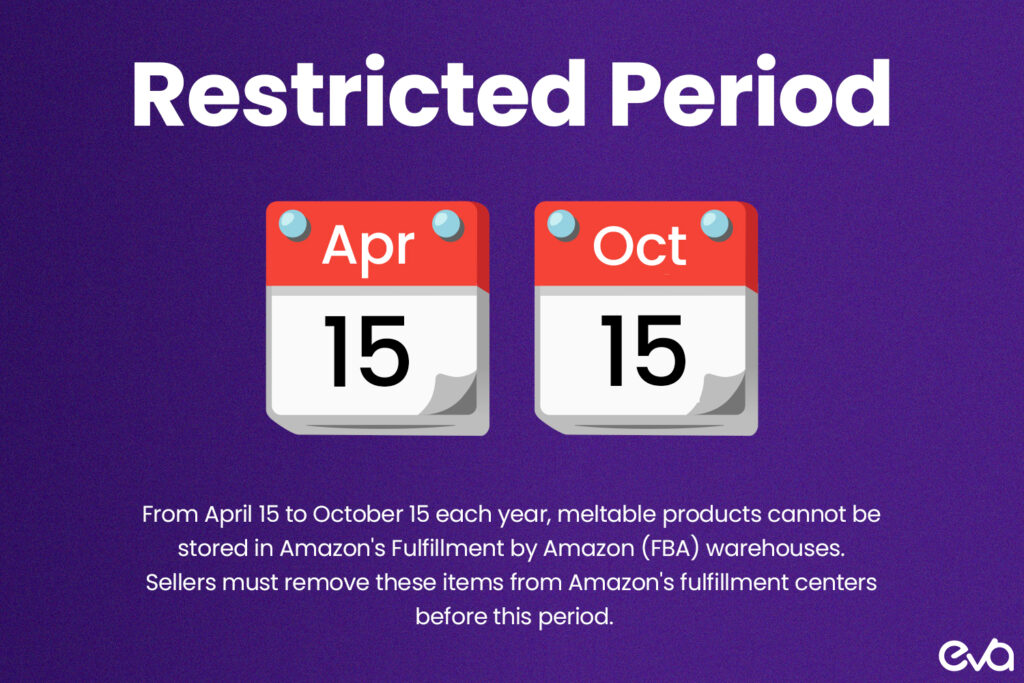
Storage Restrictions
Amazon implements several measures to protect meltable products stored in its fulfillment centers. During the warmer months, these products are typically stored in temperature-controlled environments to prevent damage.
However, there are limitations to this, as Amazon may restrict the storage of certain products altogether during peak heat periods.
Sellers must be proactive in managing their inventory to comply with these restrictions and avoid potential issues.
Table: Amazon’s Storage Guidelines for Meltable Products
| Time Period | Storage Guidelines |
| May 1 – Oct 15 | Storage of meltable products is restricted; only temperature-controlled storage allowed. |
| Oct 16 – Apr 30 | Products can be stored normally, but sellers must ensure proper packaging. |
Understanding these guidelines is crucial for sellers to manage their inventory effectively and ensure that their products remain compliant with Amazon’s policies throughout the year.
Shipping Constraints
During periods of high temperatures, Amazon may impose shipping constraints on meltable products to minimize the risk of them melting during transit.
For instance, Amazon might limit shipping to regions experiencing extreme heat or require expedited shipping options to reduce the time products spend in transit.
Sellers must be aware of these constraints and plan their shipping strategies accordingly to ensure their products arrive in good condition.
Seasonal Restrictions
One of the most critical aspects of Amazon’s meltable inventory policy is the seasonal restriction that prohibits the sale and storage of meltable items from May 1 to October 15.
During this period, sellers cannot send meltable products to Amazon’s fulfillment centers. This restriction is in place to prevent products from being stored in conditions where they could melt, leading to customer complaints and returns.
Sellers need to plan their inventory and sales strategies around these restrictions to avoid disruptions in their business.
Storage in Off-Season
During the restricted period, sellers have several options for managing their inventory:
- Third-Party Fulfillment Centers: These centers can offer temperature-controlled storage and shipping services, allowing sellers to continue fulfilling orders even during Amazon’s restricted period.
- Storing Inventory in Cooler Climates: Sellers can store their inventory in cooler climates to prevent melting and ship directly from these locations when orders are placed.
List: Storage Strategies for Meltable Products
- Utilize third-party fulfillment centers with temperature control.
- Store inventory in cooler climates during the off-season.
- Plan for increased inventory before the restriction period begins to meet demand.
By planning ahead and considering alternative storage solutions, sellers can continue to offer meltable products throughout the year, even during Amazon’s restricted periods.
Guidelines for Sellers Handling Meltable Products
Packaging is a critical factor in protecting meltable products during storage and shipping. Amazon’s guidelines stress the need for sturdy packaging that can withstand temperature fluctuations and prevent products from melting or becoming deformed.
Sellers should invest in high-quality packaging materials that provide insulation and protection against heat.
Ensuring that your products are well-packaged not only helps maintain their integrity but also reduces the risk of customer complaints and returns.
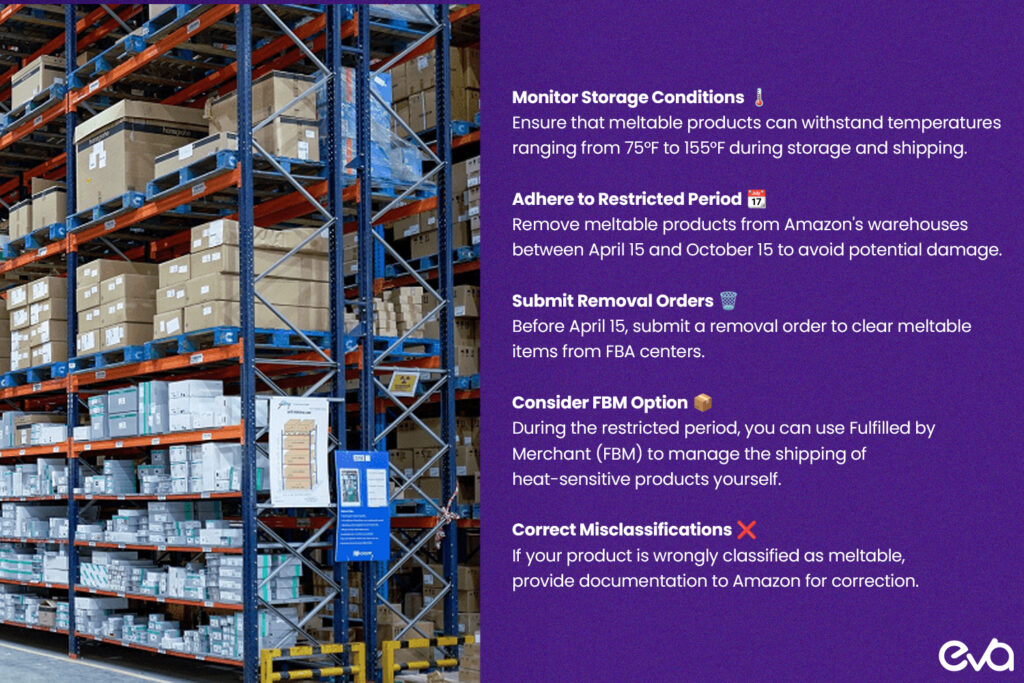
Key Packaging Materials:
- Insulated Boxes: These boxes help maintain a stable internal temperature, reducing the risk of melting during transit.
- Gel Packs: These can be used inside packages to keep the temperature low, especially during the warmer months.
- Thermal Wraps: Adding thermal wraps around products provides an additional layer of protection against heat.
Insulated Packaging
When it comes to insulated packaging, sellers have several options to choose from:
- Polystyrene Foam Boxes: These boxes are lightweight, provide excellent insulation, and are commonly used for shipping perishable goods.
- Reflective Foil Insulation: This material reflects heat away from the package, helping to maintain a cooler temperature inside.
- Gel Packs: Including gel packs in your packaging can help keep the temperature low for longer periods, especially during transit.
Comparison of Insulated Packaging Materials
| Material | Insulation Level | Cost | Best For |
| Polystyrene Foam | High | Moderate | Chocolates, cosmetics |
| Reflective Foil | Moderate | Low | Gummies, candles |
| Gel Packs | High | High | High-value meltable products |
Choosing the right packaging materials can make a significant difference in ensuring that your products arrive in good condition, even in warmer climates.
Labeling
Proper labeling is also essential for meltable products. Sellers should ensure that their products are clearly labeled with the following information:
- Temperature Sensitivity: Indicate that the product is temperature-sensitive and should be stored in a cool place.
- Handling Instructions: Provide instructions on how to handle the package, such as “Keep in a cool environment” or “Do not expose to heat.”
- Expiry Date: For food and cosmetic products, include an expiry date to ensure customers know the product’s shelf life.
These labels help inform customers and shipping personnel about the special care needed for these products, reducing the risk of damage during transit.
Storage Recommendations
Before sending products to Amazon FBA centers, sellers should take steps to ensure their meltable products are stored correctly. This includes:
- Maintaining a Cool Storage Area: Keep products in a cool, dry place to prevent any damage before shipping.
- Regular Temperature Checks: Monitor the storage environment regularly to ensure it stays within the recommended temperature range.
- Rotating Stock: Use a first-in, first-out (FIFO) system to ensure older products are shipped first, reducing the risk of sending items close to their expiry date.
Implementing these storage practices helps maintain the quality of your products and ensures they remain compliant with Amazon’s guidelines.
Shipping Tips
Shipping meltable products requires extra care, especially during the warmer months. Sellers should consider the following strategies:
- Use Expedited Shipping: Reduce the time products spend in transit by using expedited shipping options.
- Cold Packs: Include cold packs in the shipment to keep the temperature low during delivery.
- Avoid Weekend Shipping: To prevent products from sitting in a warehouse over the weekend, schedule shipments early in the week.
By following these shipping tips, sellers can reduce the risk of their products arriving melted or damaged, helping to maintain customer satisfaction.
Using Fulfillment Centers
Choosing the right fulfillment centers is crucial for sellers of meltable products. Consider the following:
- Location: Select fulfillment centers located in cooler climates to reduce the risk of products being exposed to high temperatures.
- Seasonal Changes: Be aware of the seasonal changes in the fulfillment center’s location and plan your shipments accordingly.
- Third-Party Fulfillment: For periods when Amazon’s fulfillment centers are not an option, consider using third-party fulfillment services that offer temperature-controlled storage and shipping.
By carefully selecting fulfillment centers and considering alternative options, sellers can ensure that their meltable products are stored and shipped in optimal conditions.
How to Prepare Your Meltable Products for Amazon FBA
Inspection Checklist
Before shipping your meltable products to Amazon’s fulfillment centers, conducting a thorough inspection is essential to ensure they comply with Amazon’s guidelines. This checklist can help:
- Product Condition: Ensure that all products are in perfect condition, with no signs of melting or deformation.
- Packaging Integrity: Check that the packaging is secure, with no damage that could compromise the product during shipping.
- Temperature Sensitivity Labels: Verify that all products are correctly labeled with temperature sensitivity warnings.
- Compliance Documentation: Confirm that all necessary compliance documentation is complete and ready for submission to Amazon.
By using this checklist, sellers can reduce the risk of their products being rejected by Amazon’s fulfillment centers or arriving damaged to customers.
Temperature Testing
To ensure your products can withstand the shipping process during warmer months, it’s advisable to conduct temperature testing. Controlled environment chambers can simulate the conditions your products might encounter during transit, helping you determine their resilience to heat.
Steps for Temperature Testing:
- Simulate Shipping Conditions: Place your products in a controlled environment chamber set to temperatures that they might experience during shipping (e.g., 75°F to 100°F).
- Monitor Product Integrity: Observe the products over a specified period, noting any signs of melting, deformation, or other damage.
- Adjust Packaging: If the products show signs of damage, consider enhancing the packaging with additional insulation or protective measures.
By conducting these tests, sellers can ensure that their products will maintain their quality during transit, even in adverse conditions.
Packaging Trials
Packaging trials are a critical step in preparing your meltable products for Amazon FBA. These trials involve testing different packaging materials and methods to determine the most effective way to protect your products from heat damage.
Recommended Packaging Trial Process:
- Select Packaging Materials: Choose a variety of materials, such as insulated boxes, gel packs, and thermal wraps.
- Package Test Runs: Pack sample products using different combinations of materials.
- Simulate Shipping Conditions: Subject the packages to conditions they might face during shipping, such as high temperatures and rough handling.
- Evaluate Results: Assess the effectiveness of each packaging method by checking the condition of the products after the trial.
Packaging Trial Results
| Packaging Method | Temperature Resistance | Cost | Product Condition After Trial |
| Insulated Box + Gel Packs | High | High | Excellent |
| Thermal Wrap + Foam Inserts | Moderate | Moderate | Good |
| Standard Box + Reflective Foil | Low | Low | Fair |
These trials help sellers identify the best packaging solutions, ensuring that their meltable products arrive in perfect condition.
Compliance Documentation
Amazon requires sellers to provide certain documentation to demonstrate compliance with its meltable product guidelines. This documentation may include:
- Temperature Testing Reports: Proof that your products have been tested for temperature resistance.
- Material Safety Data Sheets (MSDS): For products like cosmetics, an MSDS may be required to show that the ingredients are safe and comply with regulations.
- Product Specifications: Detailed information about the product’s temperature sensitivity, packaging materials, and handling instructions.
Essential Compliance Documents
- Temperature Testing Reports
- Material Safety Data Sheets (MSDS)
- Product Specifications
- Certification of Packaging Compliance
Ensuring that all documentation is complete and accurate helps streamline the approval process with Amazon and reduces the risk of delays or penalties.
Certifications
Certain certifications might be necessary, particularly for food and cosmetic products. These certifications can serve as proof that your products meet safety and quality standards.
Common Certifications:
- FDA Approval: Required for food and cosmetic products sold in the United States.
- ISO Certification: Indicates that your packaging and handling processes meet international standards.
- GMP Certification: Good Manufacturing Practice certification ensures that products are consistently produced and controlled according to quality standards.
Obtaining the necessary certifications not only helps you comply with Amazon’s guidelines but also builds trust with consumers, as it demonstrates your commitment to product quality and safety.
Consequences of Non-Compliance
Policy Violations
Failing to comply with Amazon’s meltable product guidelines can lead to severe consequences. Policy violations occur when sellers ignore or fail to meet the standards set by Amazon, such as improper packaging, inadequate labeling, or shipping products during restricted periods.

Potential Penalties for Policy Violations:
- Product Removal: Amazon may remove non-compliant products from its marketplace.
- Listing Suppression: Your product listings could be suppressed, making them invisible to potential buyers.
- Fines: Sellers might incur fines for repeated violations or severe non-compliance.
These penalties can significantly impact your business, both financially and reputationally.
Account Suspension
One of the most severe consequences of non-compliance is account suspension. Amazon takes its policies seriously, and repeated violations or significant breaches of its guidelines can lead to the suspension of your seller account.
Risks Leading to Account Suspension:
- Multiple Policy Violations: Continuous failure to comply with meltable product guidelines.
- High Rate of Customer Complaints: If customers frequently report receiving melted or damaged products.
- Ignoring Amazon Warnings: Failing to address issues after receiving warnings from Amazon.
An account suspension can be devastating, as it halts all your sales activities on the platform and can be challenging to resolve.
Customer Returns and Complaints
Non-compliance can also lead to a high rate of customer returns and complaints. Customers who receive melted or damaged products are likely to return the items and leave negative feedback, which can harm your seller rating and overall reputation on Amazon.
Impact of Customer Complaints:
- Reduced Seller Rating: Negative feedback lowers your seller rating, affecting your visibility and sales.
- Increased Return Costs: The cost of processing returns, including shipping and restocking fees, can eat into your profits.
- Loss of Trust: Repeated issues with product quality can lead to a loss of trust among your customer base.
To avoid these problems, it’s crucial to follow Amazon’s meltable product guidelines carefully and ensure that your products are properly packaged and shipped.
Best Practices to Avoid Issues
To prevent the consequences of non-compliance, sellers should follow these best practices:
- Regularly Review Amazon Guidelines: Stay updated on any changes to Amazon’s policies regarding meltable products.
- Invest in Quality Packaging: Make sure your packaging meets Amazon’s standards and can protect your products during shipping.
- Conduct Routine Inspections: Regularly check your products and packaging to ensure they are in compliance with Amazon’s guidelines.
- Respond to Amazon Warnings: If Amazon notifies you of an issue, address it promptly to avoid further penalties.
By following these best practices, sellers can minimize the risk of non-compliance and maintain a strong presence on Amazon.
Strategies for Selling Meltable Products Year-Round
During Amazon’s restricted periods for meltable products, sellers can explore alternative fulfillment options to keep their business running smoothly. One effective strategy is to use third-party fulfillment centers that offer temperature-controlled storage and shipping.
Benefits of Third-Party Fulfillment:
- Temperature Control: These centers can store your products in controlled environments, ensuring they remain in good condition.
- Flexibility: Sellers can continue to fulfill orders even during Amazon’s restricted periods.
- Cost-Effective: In some cases, third-party fulfillment may offer more cost-effective solutions compared to Amazon FBA.
By leveraging third-party fulfillment centers, sellers can maintain sales and customer satisfaction year-round, even when Amazon imposes restrictions.
Dropshipping
Dropshipping can be another viable strategy for selling meltable products year-round. With dropshipping, you can avoid the complexities of storing and shipping products yourself, as the supplier handles these aspects.
Advantages of Dropshipping:
- No Need for Storage: Since the supplier ships directly to the customer, there’s no need to worry about storage conditions.
- Reduced Risk: Sellers don’t have to invest in large inventories, reducing the financial risk if products don’t sell as expected.
- Scalability: Dropshipping allows sellers to scale their business without the need for additional storage or shipping resources.
While dropshipping can be a useful strategy, it’s important to choose suppliers who can meet Amazon’s meltable product guidelines to ensure customer satisfaction.
Cold Shipping Solutions
For sellers who prefer to maintain control over their fulfillment process, investing in cold shipping solutions can extend the selling season for meltable products.
Cold Shipping Solutions to Consider:
- Refrigerated Shipping Containers: These containers are ideal for bulk shipments and can maintain a low temperature throughout transit.
- Cold Packs: Adding cold packs to individual shipments can help keep products cool, even during warmer months.
- Temperature Monitoring: Use temperature monitoring devices to track the conditions of your shipments and ensure they stay within safe limits.
These solutions allow sellers to ship meltable products safely during warmer periods, reducing the risk of damage and ensuring customer satisfaction.
Marketing Tips
Maximizing sales of meltable products requires effective marketing, especially during the non-restricted periods.
Sellers should focus on promoting these products heavily during the cooler months when they can be shipped without restrictions.
Marketing Strategies:
- Seasonal Promotions: Run promotions during the cooler months to boost sales and encourage bulk purchases.
- Highlight Temperature Sensitivity: Educate customers on the importance of proper storage and handling, emphasizing the premium quality of your products.
- Leverage Social Media: Use social media platforms to showcase your products and engage with your audience, building anticipation for new releases.
By implementing these marketing strategies, sellers can optimize sales and maintain a steady revenue stream throughout the year.
Promotional Campaigns
Running promotional campaigns before the restricted season begins can also help maximize sales. Consider offering discounts or special deals on meltable products to encourage customers to purchase before the restrictions take effect.
Examples of Promotional Campaigns:
- Limited-Time Offers: Offer discounts on bulk purchases to encourage customers to stock up before the restricted period.
- Early Bird Discounts: Provide incentives for customers who purchase meltable products before the warmer months.
- Bundle Deals: Create product bundles that include meltable items, offering customers added value.
These promotional campaigns can help drive sales and reduce inventory before Amazon’s restricted period, ensuring that your products don’t go to waste.
How Eva Can Help with Managing Meltable Products on Amazon
Managing meltable products on Amazon can be challenging, but Eva provides tools that simplify the process and make it more efficient.
Whether you’re keeping track of inventory, improving shipping methods, or following Amazon’s guidelines, Eva’s platform supports sellers every step of the way.
Eva’s Features and Benefits:
Real-Time Inventory Monitoring: Eva gives you up-to-the-minute updates on your inventory, so you always know what’s in stock and can manage your meltable products effectively.
This helps you avoid running out of stock or overstocking during restricted periods on Amazon.
Planning for Seasons: Eva helps you manage your inventory according to Amazon’s seasonal restrictions.
This planning makes sure your products are only available when it’s safe, helping you avoid problems with customer complaints and non-compliance.
Cold Shipping Options: Eva offers guidance on choosing and using cold shipping methods, which helps keep your products from melting during delivery.
This is particularly useful during warmer months when maintaining product quality can be more difficult.
Automatic Shipping Adjustments: Eva’s system adjusts your shipping methods based on weather forecasts, ensuring that your products reach customers in good condition.
This reduces the chance of damage and improves customer satisfaction.
What Makes Eva Stand Out:
- AI Technology: Eva uses advanced technology to improve various aspects of your Amazon business, from managing inventory to optimizing shipping.
- Expert Support: Eva offers access to experienced professionals who provide personalized advice, helping you manage meltable products more effectively.
- Innovative Tools: Eva includes features like automatic temperature-based shipping adjustments that aren’t available with many competitors.
Benefits for Sellers:
Using Eva’s platform offers several advantages:
- Greater Efficiency: Streamlined processes for managing inventory and shipping reduce the workload and minimize mistakes.
- Better Product Quality: Improved shipping methods ensure that products arrive in good condition, leading to happier customers and fewer returns.
- Cost Savings: By optimizing shipping and reducing the risk of product damage, sellers save money that would otherwise be spent on handling returns and addressing complaints.
- Compliance Support: Eva’s tools help you stay within Amazon’s guidelines, reducing the risk of penalties or having your account suspended.
At Eva, we’re dedicated to helping you manage your meltable products on Amazon effectively. With our tools and expert support, you can rest easy knowing your products are in good hands, no matter the season.
Managing meltable products on Amazon requires careful planning, adherence to guidelines, and the right tools. Eva offers a complete solution for sellers looking to improve their meltable product sales and follow Amazon’s strict guidelines.
Explore Eva’s services today to elevate your Amazon business and keep your meltable products safe.
Conclusion
Selling meltable products on Amazon presents unique challenges, but with the right strategies and tools, it’s possible to succeed in this niche market.
Key takeaways include the importance of understanding Amazon’s meltable product guidelines, investing in quality packaging, and exploring alternative fulfillment options during restricted periods.
Sellers dealing with meltable products should be proactive in ensuring compliance with Amazon’s guidelines.
Regularly review your processes, conduct packaging trials, and consider using tools like Eva to manage your inventory and shipping.
By staying informed and prepared, you can minimize the risks associated with meltable products and maximize your sales potential.
Take action today by reviewing your current processes and ensuring your meltable products are compliant with Amazon’s guidelines.
Consider using Eva’s comprehensive tools to enhance your management and optimization efforts, keeping your products safe and your customers satisfied.
FAQs
Yes, but with certain restrictions. Amazon prohibits the storage and shipping of meltable products through its FBA program from May 1 to October 15. However, you can use third-party fulfillment centers or alternative strategies, such as dropshipping, to continue selling meltable products during this period.
If your products melt during shipping, you may face customer complaints, returns, and negative feedback. Repeated issues can lead to penalties from Amazon, including product removal or account suspension. To prevent this, ensure your products are properly packaged and shipped using cold packs or expedited shipping methods.
The right packaging depends on the specific product and its temperature sensitivity. Insulated boxes, gel packs, and thermal wraps are common solutions for protecting meltable products during shipping. Conduct packaging trials to determine the best combination of materials for your products.
Amazon’s meltable product guidelines apply universally to all products that meet the temperature sensitivity criteria. There are no exemptions, and all sellers must comply to avoid penalties.
Eva provides several unique features specifically tailored to the needs of sellers managing meltable products:
Inventory Management: Eva’s platform offers real-time inventory tracking, ensuring that your meltable products are stored and shipped in compliance with Amazon’s guidelines.
Temperature Monitoring: Eva includes tools that monitor the conditions of your inventory, helping you avoid temperature-related issues.
Automated Adjustments: Eva’s system can automatically adjust shipping methods and storage locations based on temperature forecasts, minimizing the risk of product damage.

